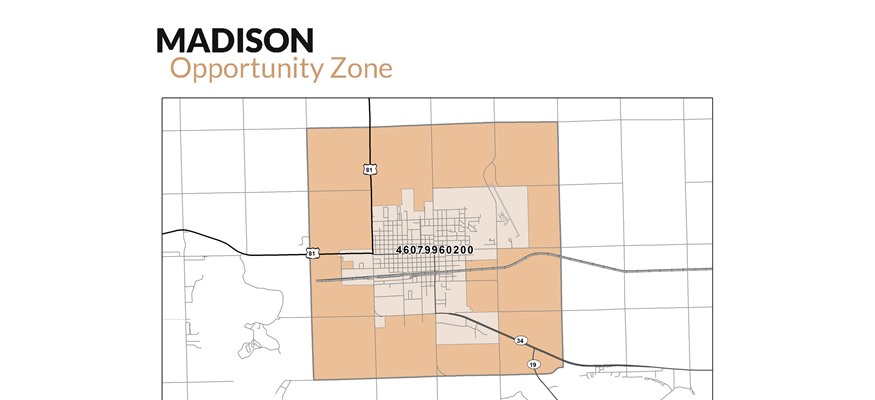
This map is from the Opportunity Zone Presentation.
By Mary Gales Askren, courtesy of the Madison Daily Leader
Last year's federal tax reform bill included a component creating Opportunity Zones that could benefit South Dakota communities, including Madison, according to the Governor's Office of Economic Development (GOED).
"It's designed to give tax breaks to investors," Deputy Commissioner Aaron Scheibe told a smattering of community leaders on Monday afternoon.
Scheibe was in Madison to talk about the community's status as an Opportunity Zone. That designation by the U.S. Department of Treasury enables investors to reinvest capital gains in local projects without paying taxes on that income for 10 years.
Madison is one of 25 census districts in 17 South Dakota counties to receive this designation. The designation resulted from a two-step process, according to Scheibe.
First, the Treasury Department identified qualifying districts based on the American Community Survey. Second, the GOED, working with several other agencies, narrowed the list to 25, the number allowed by the federal government.
"We had to figure out which of our children we liked best," Scheibe joked.
Three criteria were used at the state level: whether a district was primed for business creation, whether a district was primed for housing creation, and general community readiness.
"Madison stacked up very well in our state," Scheibe said.
The census district is a 16-square-mile area which is bordered by 231st Street on the north, 457th Avenue on the east, 235th Street on the south and 453rd Avenue on the west. The entire community, including the industrial park and airport, are included in the Opportunity Zone.
The GOED will not know until at least October exactly how the program will work. Scheibe shared what the state knows at this time.
Investors will put capital gains into Opportunity Funds which are then invested in for-profit businesses. At the end of 10 years, investors benefit in two ways. First, they pay taxes on only 85 percent of the funds invested. Second, they pay no taxes on any of the project's capital gains.
Scheibe used the example of Amazon stock purchased at $20 per share and sold at $200 per share. If the investor put $180 into an Opportunity Fund, he would be taxed on $153 at the end of the 10-year period.
"If you double your money, the $180 gained is never taxed," he explained.
Unlike other federal programs, qualifying is expected to be simple because individuals will self-certify, according to Scheibe. This is expected to involve completing a form that is attached to the investor's tax form and submitted to the IRS.
Scheibe emphasized a number of unknown variables.
"Could you use this as an individual investor or small business owner?" he asked.
The state does not know. For example, if a small business owner sells a quarter of land and puts the income in an Opportunity Fund, the state does not know if that business owner could invest in his own business.
The state does not know if a minimum number of people will need to invest in an Opportunity Fund. The state does not know the technical definition of terms which are being used. The state does not know how the program will impact those who do not invest until 2020.
"The devil is in the details with these things," Scheibe said.
Despite the unknowns, the GOED expects the program to be a powerful tool in South Dakota.
"It's a way to get money out there that wouldn't be out there," Scheibe said.
He warned that additional money would not "make a bad project into a good one," but he said it could increase investment in borderline projects -- those which "pencil out" but don't promise a huge return. He said the tax incentives increase the return, which could motivate investors.
Being designated an Opportunity Zone does not guarantee investment. Scheibe said it was still up to economic development staff and community leaders to attract business prospects and develop projects.
"It's not going to create projects on its own," he said.
No federal funding is available for this program; it relies entirely on private investors. However, Scheibe said, Opportunity Funds can be stacked with state and federal programs to finance projects.
In addition, the GOED believes the Opportunity Zone designation could attract funding from large investment firms.
"They're going to have people out looking for opportunities," Scheibe said.
He believes the nature of this funding source will benefit communities like Madison because no matching funds are required. In addition, there are fewer limitations on the way the funding can be used.
"From the business standpoint, it's just like taking on another partner," he said.
To date, no one has come up with a model for using Opportunity Funds for a single-residence housing development because the funds can only be invested, not loaned. However, Scheibe recommended creative thinking could overcome that obstacle.
nbsp&
If you would like more information about Madison's Opportunity Zone, please contact the LAIC office. More information from the IRS, such as definitions, parameters, etc. are expected to be released at the end of October 2018.